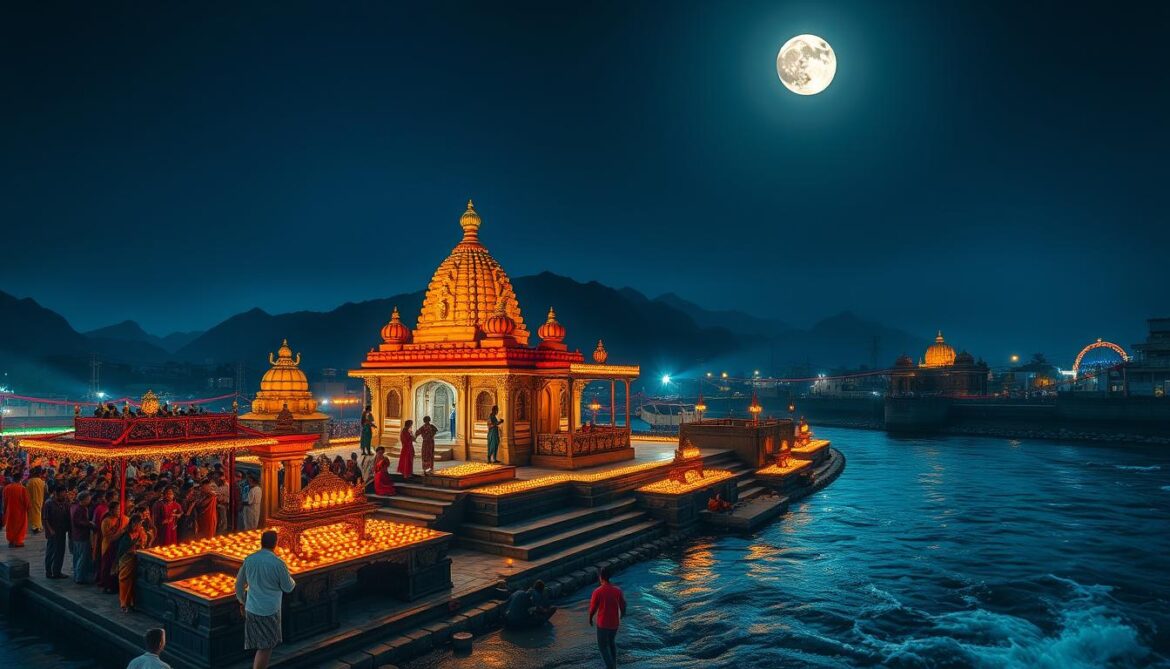Maha Shivaratri is a big Hindu festival. It happens every year in February or March. It’s tied to the Hindu lunar calendar.
This festival is to honor Lord Shiva. He stands for divine masculine energy and is called “The Great Destroyer.” It’s a time for people to connect with Shiva’s energy. They do this through deep thinking and saying mantras like “Om Namah Shivaya.”
It’s a time to remember overcoming darkness and ignorance. People remember Lord Shiva, fast, and meditate on important values.
These values include honesty, not hurting others, giving to charity, forgiving, and finding Shiva. It’s a big part of the Hindu festival calendar.
What is Maha Shivaratri?
It happens on the fourteenth day of the waning moon in Phalguna. The Maha Shivaratri date is usually in late February or early March. It celebrates the wedding of Shiva and Parvati, showing balance and harmony in the world.
The Maha Shivaratri celebration includes fasting, studying, and staying up all night. People do these things to beat darkness and find spiritual meaning. Big Shiva temples, like those in Varanasi and Somanatha, are filled with devotees from all over India.
- Commemoration of the wedding of Shiva and Parvati
- Representation of the balance and harmony in the universe
- Observances such as fasting, self-study, and all-night vigils
- Celebrations at major Shiva temples across India
The Maha Shivaratri significance is tied to Hindu philosophy. Its Maha Shivaratri date is something devotees look forward to every year. It’s a time for spiritual growth, self-discovery, and connecting with the divine.
Historical Origins of Maha Shivaratri
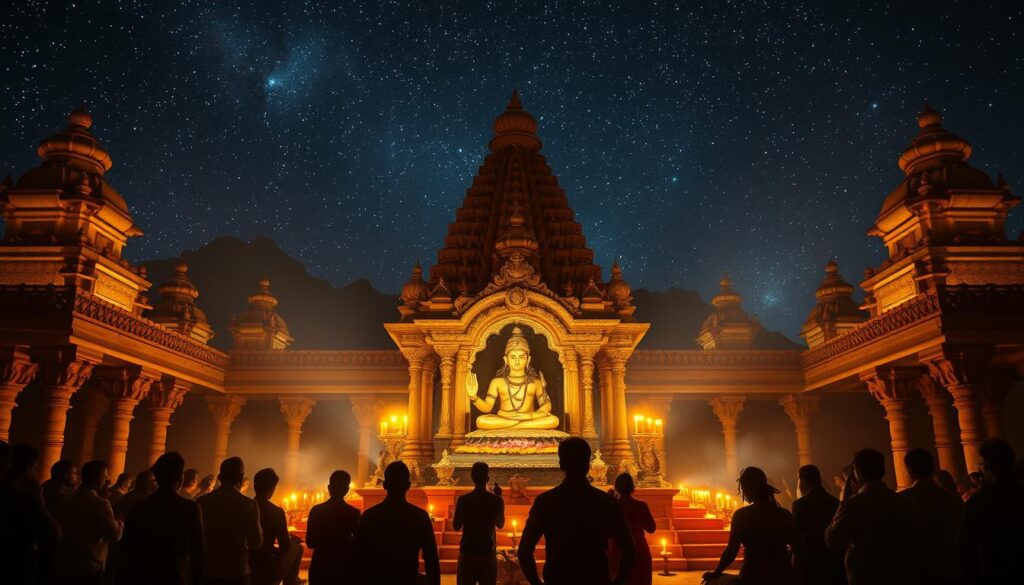
Maha Shivaratri history is rich and spans thousands of years. It started in the 5th century BCE. The festival’s roots are in ancient texts and scriptures.
To understand Maha Shivaratri, we must look at its history and cultural growth. This helps us see why it’s so important.
The origins of Shivaratri are tied to Hindu mythology. It’s mentioned in the Puranas and Upanishads. These texts give us insights into the festival’s meaning and rituals.
Key parts of Maha Shivaratri history include:
Ancient Texts and Scriptures
- The festival’s mention in ancient texts like the Mahabharata and Ramayana
- The importance of the lunar month of Phalguna or Magha in Hindu mythology
- The connection of Maha Shivaratri with the marriage of Lord Shiva and Goddess Parvati
Exploring Maha Shivaratri history shows its cultural growth. From ancient India to global celebrations, it has changed yet stayed true to its core.
Cultural Evolution Over the Years
Today, Maha Shivaratri is celebrated with great fervor. Millions of devotees join in. Its cultural evolution shows its lasting importance and the strength of faith and tradition.
Rituals and Traditions on Maha Shivaratri
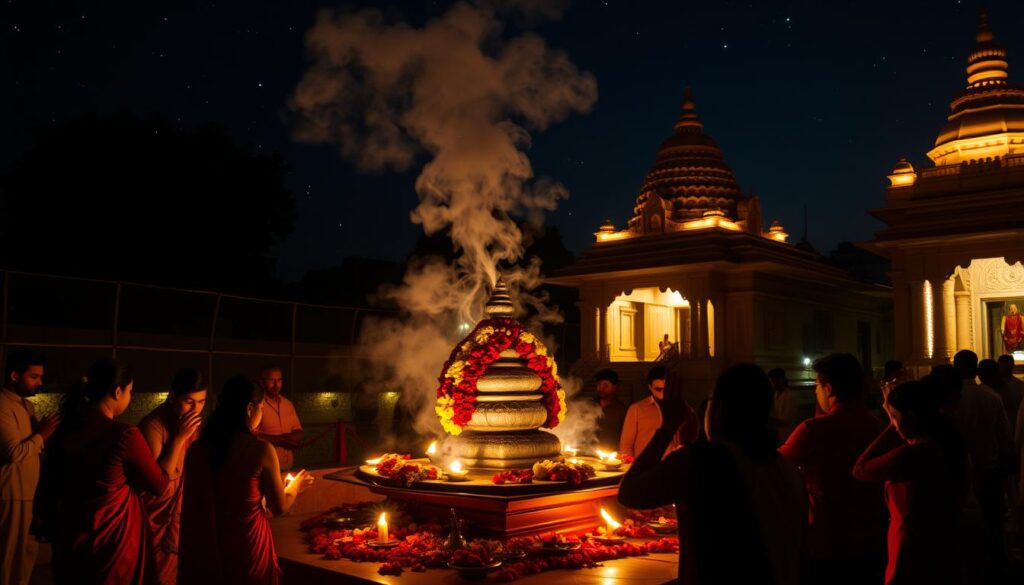
Maha Shivaratri rituals are key to the celebration. Devotees do many spiritual practices to honor Lord Shiva. A big Shivaratri tradition is fasting for 24 hours. This is to overcome darkness and ignorance.
At night, people join a jagarana. It’s a vigil and prayers to worship Lord Shiva. The Maha Shivaratri rituals also include bathing the Shivalinga, usually done by women. They offer fruits, flowers, and incense sticks too.
Worship of Lord Shiva goes all night. Devotees chant “Om Namah Shivaya” and do puja for spiritual cleansing. Decorating the Shivalinga with flowers shows devotion.
- Fasting and spiritual practices
- Night vigil and worship
- Special offerings to Shiva, such as fruits, flowers, and incense sticks
- Ritual bath of the Shivalinga
- Chanting of “Om Namah Shivaya”
These Shivaratri traditions are vital. They help devotees connect with Lord Shiva. It’s a time for spiritual growth and freedom.
The Symbolism of Maha Shivaratri
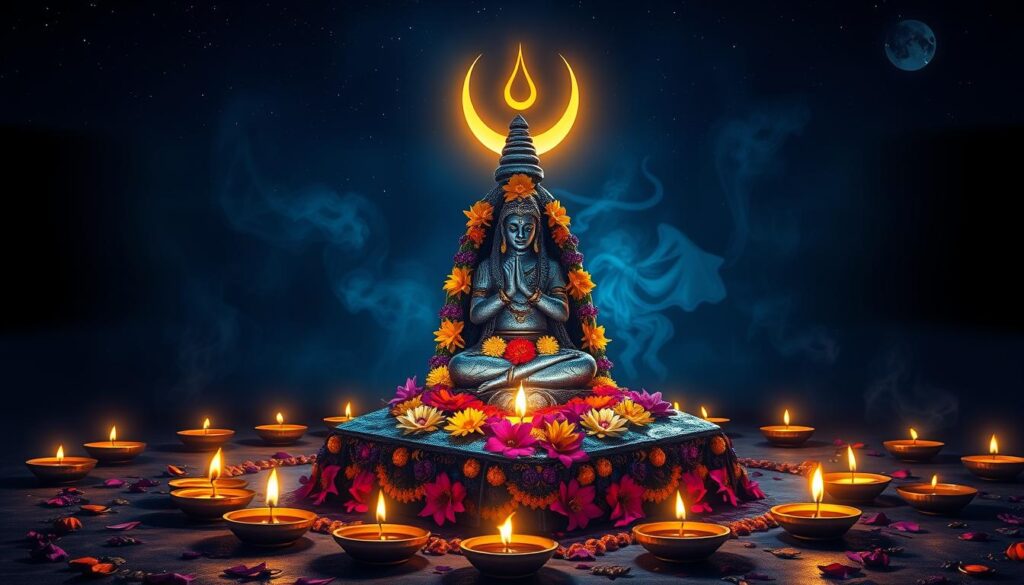
Maha Shivaratri is a special festival that happens once a year. But, there are 12 Shivaratris in a year, based on the lunar calendar. It’s about finding the divine within us, like Shiva.
The festival takes place on the 14th day of the dark half of Phalguna month. This usually happens in February or March. Shivaratri means “the night of Shiva.” It’s a time for quiet and inner peace.
Understanding Lord Shiva’s Iconography
Lord Shiva’s images are key in Maha Shivaratri. His art and stories are seen in many places with Hindu people. Shiva’s dance shows the cycle of life, death, and rebirth.
The Importance of Darkness and Light
The night of Maha Shivaratri is special. It shows the change from dark to light. People celebrate with fasting, meditation, and worship.
Celebrating Maha Shivaratri in India
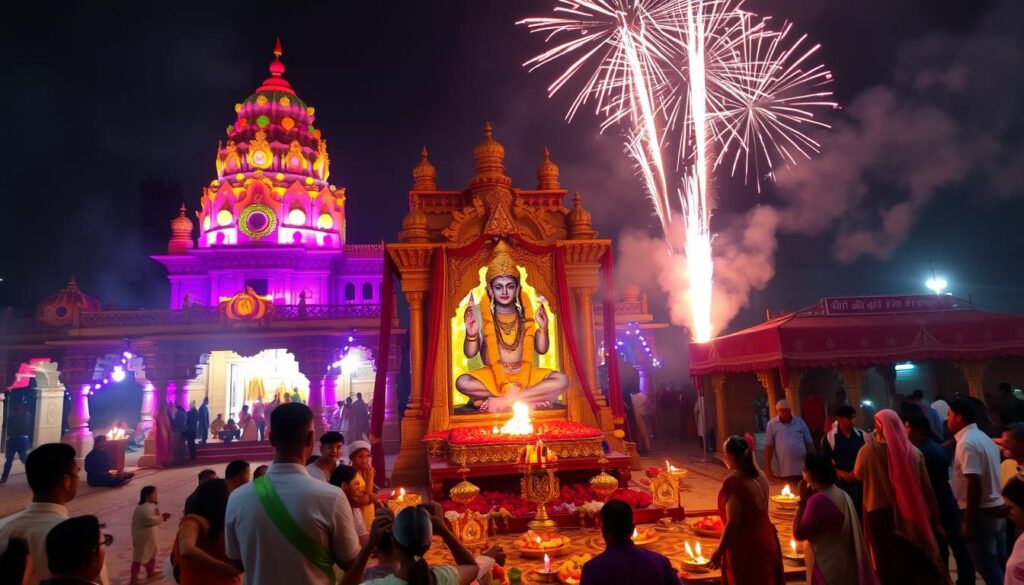
Maha Shivaratri in India is a big festival. Shivaratri celebrations happen all over the country. It’s a time for spiritual growth and thinking about ourselves.
Regional Variations in Celebrations
The Maha Shivaratri in India is celebrated with lots of energy. Different places celebrate it in their own way. Some people fast all day, while others fast for part of the day.
Famous Temples and Their Activities
Some famous temples in India are very important during Shivaratri celebrations. The Mahakal Temple in Ujjain and the Kashi Vishwanath Temple in Varanasi are key places. People go there to pray, do rituals, and meditate.
The Maha Shivaratri in India is a chance for spiritual growth. It’s a time to connect with the divine. The festival celebrates the union of Lord Shiva and Goddess Parvati. It’s also a time for self-reflection.
Maha Shivaratri Around the Globe
Maha Shivaratri is celebrated worldwide, showing deep respect for Shiva. It happens on the 14th day of Phalunga, or Magha. Millions of Hindus join in across India and globally.
The festival shows the rich diversity of Hindu culture. Shivaratri globally is a time for spiritual reflection. Many fast for a day and attend night vigils and special services.
Celebrations in Different Countries
In Nepal and India, Maha Shivaratri is a big deal. Thousands go to places like the Pashupatinath Temple in Nepal. There, people sing and dance all night at temples.
It’s also celebrated in big cities like New York City, Atlanta, Dallas, London, and Kitchener. This shows how Maha Shivaratri is known worldwide.
Influence on Local Cultures
Maha Shivaratri deeply affects local cultures. It’s a key part of many communities’ lives. The festival brings people together, showing shared values and traditions.
The Role of Devotees in Maha Shivaratri
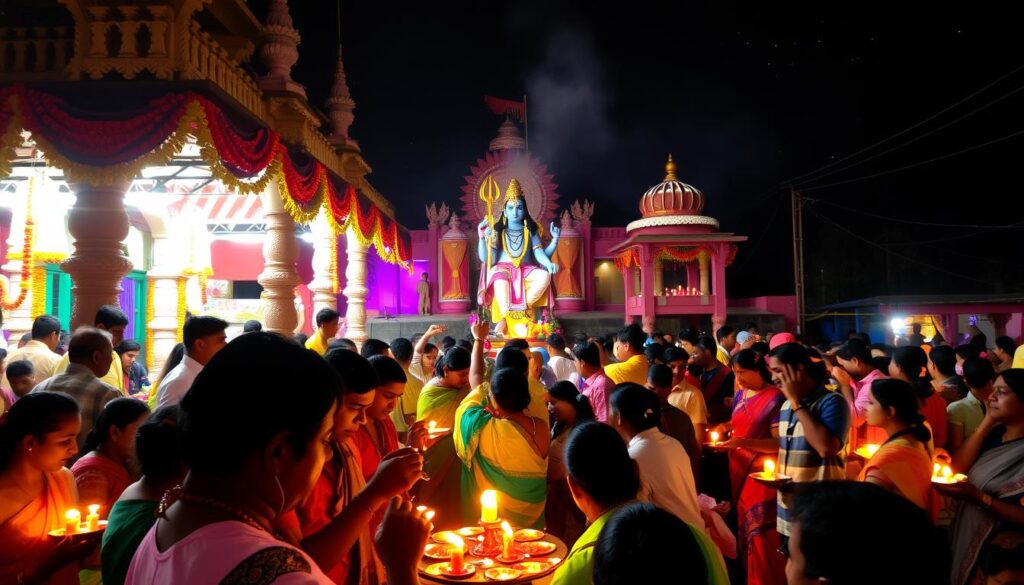
Maha Shivaratri devotees are key to the festival’s joy. They show their love through many rituals and traditions. Shivaratri followers fast for about 24 hours. They also meditate, chant, and pray together.
They honor Shiva by saying the Shiva Chalisa. They also bathe the Shiva Lingam with sacred water. The night is split into four parts. In each part, they do rituals and chant special mantras.
Community events are big on Maha Shivaratri. People gather around fires called Dhuni. It’s a special night for spiritual growth and thinking.
Connection to Meditation and Yoga
Maha Shivaratri and meditation and yoga are closely linked in Hindu philosophy. The festival is marked by all-night vigils and rituals. During these, people do spiritual practices like meditation and yoga. These practices aim to bring spiritual joy and freedom, the main goal of Maha Shivaratri philosophy.
Emphasis on Inner Transformation
The focus on changing from the inside out is a big part of Shivaratri Hindu philosophy. The festival pushes people to think about their inner selves and grow spiritually. The rituals and practices, like fasting and meditation, help people reach a higher consciousness. This leads to inner change and spiritual freedom.
How to Prepare for Maha Shivaratri
To get ready for Maha Shivaratri, focus on spiritual preparation and setting up a sacred space at home. This festival is for looking inward and growing spiritually. Good preparation will help you enjoy it fully.
Here are some Shivaratri tips to help you prepare:
- Start by cleansing your body and mind through meditation and yoga
- Create a sacred space at home by decorating it with flowers, candles, and other spiritual symbols
- Fast or observe a partial fast to detoxify your body and mind
- Stay hydrated by drinking plenty of water and other fluids
By following these Maha Shivaratri preparation tips, you can have a meaningful and spiritual experience. Remember to stay focused, calm, and hydrated during the festival.
Connecting with Shiva: Meditation Practices
Maha Shivaratri meditation helps us connect with Lord Shiva. It leads to spiritual growth. Devotees use guided meditations and chant Shivaratri mantras during this festival.
Guided Meditations for Maha Shivaratri
Guided meditations help us focus and connect with Shiva’s energy. They use visualization, breathing, and sacred mantras like Om Namah Shivaya.
Mantras and Chants to Invoke Shiva
Shivaratri mantras are key in Maha Shivaratri meditation. Chanting these mantras calls upon Lord Shiva’s presence. Some well-known mantras are:
- Om Namah Shivaya
- Maha Mrityunjaya Mantra
- Kleem Kalikaaye Namah
By using Maha Shivaratri meditation and Shivaratri mantras, devotees grow closer to Lord Shiva. They experience deep spiritual growth.
Conclusion: Embracing the Essence of Maha Shivaratri
As Maha Shivaratri ends, we must think about its deep meaning. It teaches us to beat darkness with light. Lord Shiva shows us that change means leaving old ways behind.
Reflection and Personal Growth
Maha Shivaratri makes us look inside, finding our spiritual side. Meditation and yoga help us know ourselves better. We can keep Maha Shivaratri’s lessons alive all year.
Continuing the Celebration Year-Round
Maha Shivaratri’s spirit stays with us all year. By praying and helping others, we keep its spirit alive. Let it light our way to a better life, full of divine connection.

